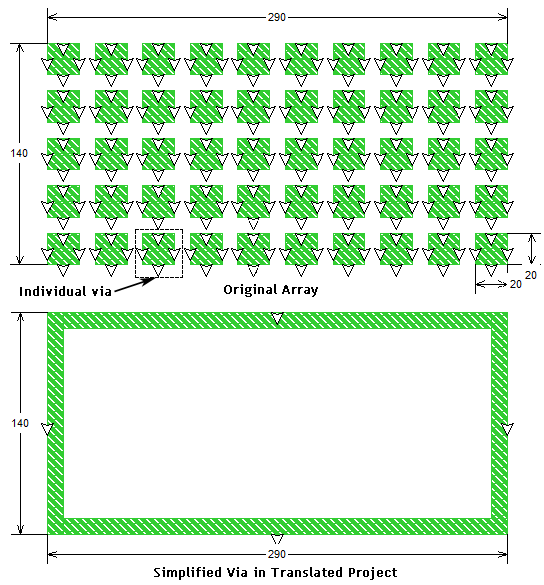 \
\
 \
\
Array Loss Model
The array via loss model is used for computing the loss of via arrays which have been simplified using the via array simplification feature in one of Sonnet’s Translators. Like the Volume loss model, it is a frequency-dependent model. The only difference between the Volume model and this model is the method by which the cross-sectional area is computed. With the Volume model, the cross-sectional area is computed based on the wall thickness or solid setting. For the Array model, the cross-sectional area is computed using the Fill Factor or Density which is based on the original via array.
Specify Using: You may chose to define your metal loss using Conductivity, Resistivity or Resistance Per Via. Select which value you wish to use from this drop list. The value entered should be that of the original metal used for the via array. The dialog box is updated to include a text entry box for whichever choice you make in the drop list; the units are displayed to the right of the text entry box. You may use a variable to define the conductivity, resistivity or resistance per via.
Fill Factor: The Fill Factor is a loss parameter when you are defining the loss using Conductivity or Resistivity. The fill factor is a percentage indicating how much of the cross-sectional area of the original via array is metal filled. The Fill Factor is calculated by summing the areas of all the individual vias in the array and dividing that by the total area of the array, defined as the bounding box which surrounds all the vias in the array. The result is multiplied by 100 to convert to a percentage. An example of an array and how to compute it's Fill Factor is shown below.
The array, shown on top, consists of a 5 X 10 array of 50 via contacts whose cross section is a 20 micron X 20 micron square. Therefore the sum of the areas of all the contacts is 50 X 400 = 20,000 square microns. The total cross-sectional area of this array is 40,600 square microns (290 microns X 140 microns). This provides a Fill Factor of 49.3% ((20,000/40,600) X 100). The converted simple via modeled in Sonnet is shown on the bottom. Although the total cross sectional area of the simplified via is 40,600 microns, the Array loss model is set such that the calculated DC loss for the via is based on the loss of the actual metal in the array, (40,600 X .493 = 20,015.8) i.e., the 20,000 square microns.

If there are two or more arrays which use the same metal type but whose fill factors differ significantly, two or more via metal types are created in the Sonnet project. For example, there are two arrays, one with a fill factor of 50% and another of 75% both using a metal named “viametal1.” The translated project will contain two via metal types called “viametal1_1” and “viametal1_2.”
Resistance: A loss parameter when specifying loss using Resistance Per Via. The total vertical (Z) resistance of an individual via within the array in Ohms/via. See below for the loss definition.
Density: A loss parameter when specifying loss using Resistance Per Via. The density of vias in the array in vias per square micron. See below for the loss definition.
Resistance Per Via for the array model represents the vertical (Z) resistance in Ohms of an individual via within the via array. The Array loss model is used when an array of vias is modeled as a single, merged via polygon, but the loss for that simplified polygon is based on the actual metal present in the array. The loss parameters of this simplified via polygon are Resistance Per Via (Rper_via) in Ohms/via and Via Density (Dvia) in vias per square micron. The total resistance in Ohms of the simplified via polygon is constant with frequency and is computed as follows:
Rsimplified_via = Rper_via/(Dvia * Avia)
where Avia is the cross-sectional area of the simplified via polygon in square microns.
The horizontal loss at DC and RF for the Array model is infinite.